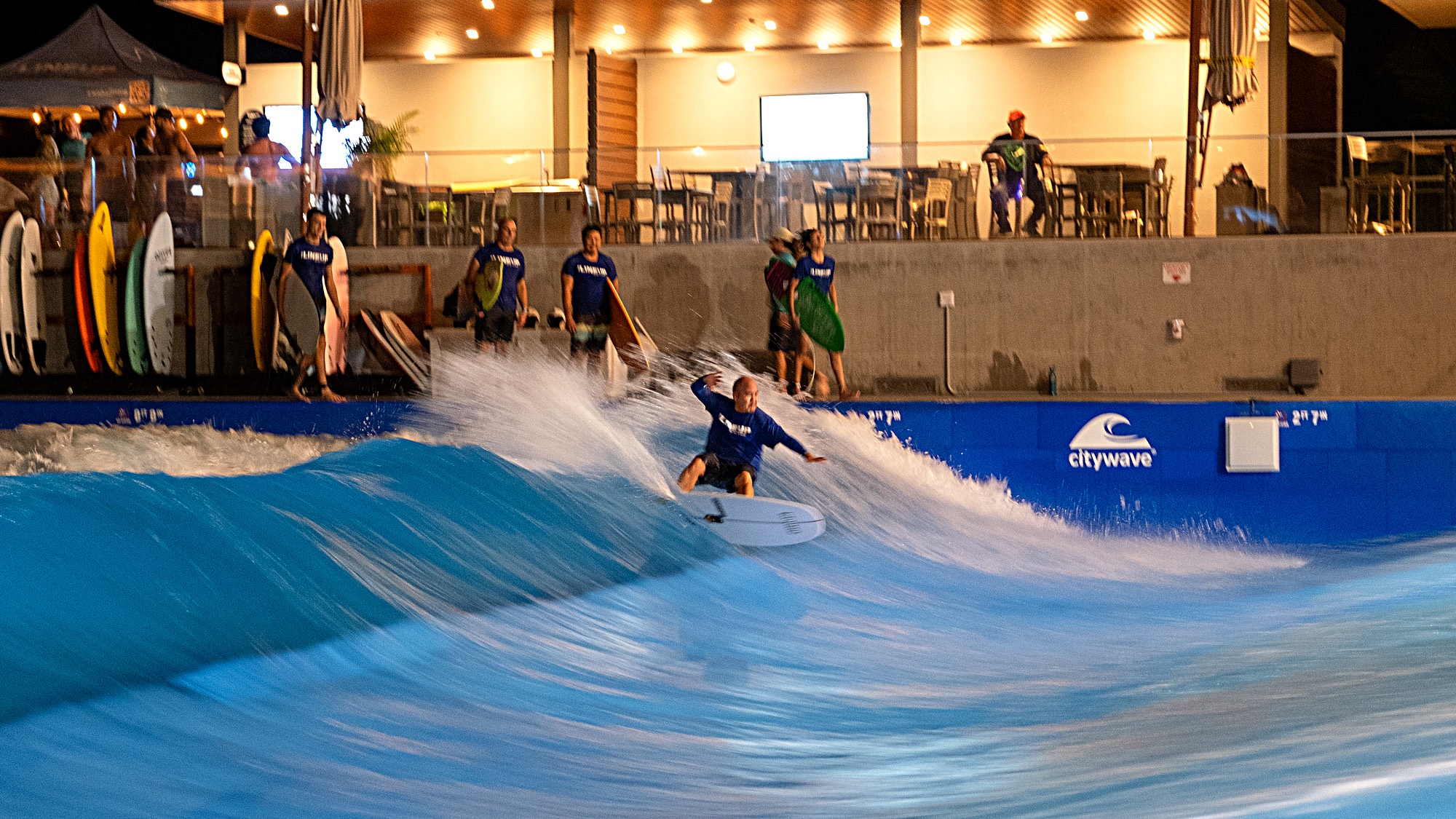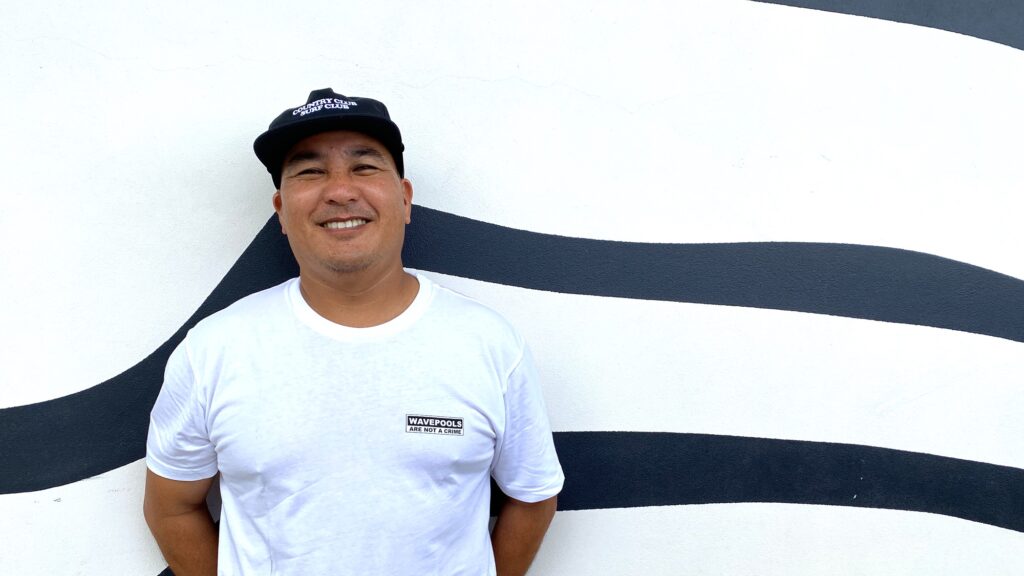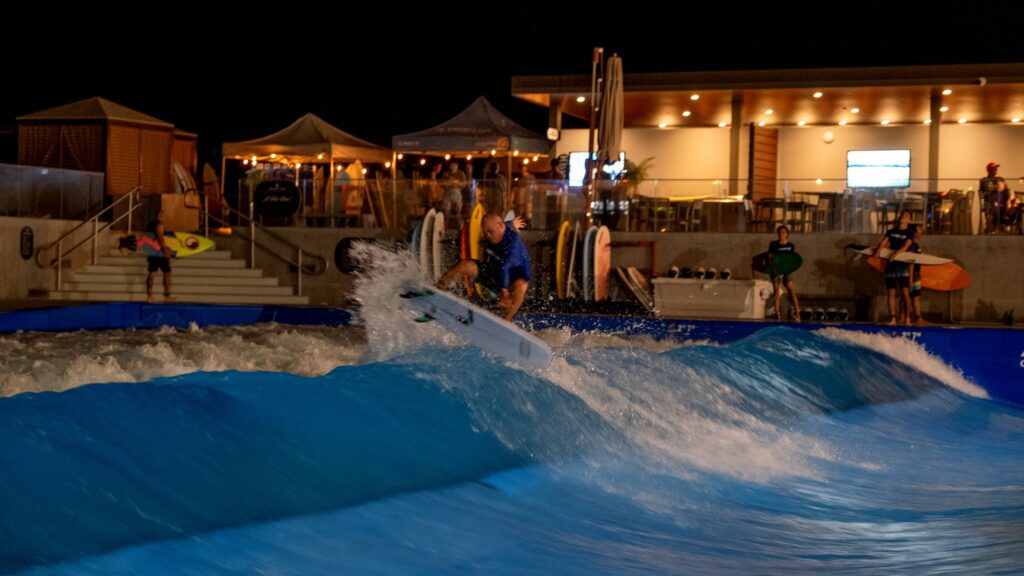Hawaiian Pro Jason Shibata gives tips for the salted set on how to ride a rapid wave

Jason Shibata shares a few things with Kelly Slater. To surf nerds he’s the other 2011 WSL mathematical error of note (after Kelly’s premature world title crowning) when commentators gave Jason a loss for his Pipeline heat when in fact he’d advanced. This year he shared another moment with Kelly, this time at the Lineup at Wai Kai wave pool, Jason’s place of work.
For many ex-pros, careers are limited. Pro surf veterans of yesteryear had few options: either start up a surf school or sling clothes for their longtime sponsors. At least, that used to be the pathway. Today with wave pools, many ex-pros are taking their hard-earned surf knowledge and technique and sharing it with everyday surfers. Enter the new era of wave pools and the increased demand for skilled coaches.
What is your job title here?
My job here is high-performance coach.
How does high-performance coaching differ from, say, just average coaching?
Specifically, high-performance surf coaching would be helping people work on their maneuvers, really working on their technique. I mean, I work with people who’ve never surfed before, but also with a focus on high performance, meaning I help them to get more radical on their technique by focusing on body mechanics and even working with them on their airs. So a lot of people who come here are in the high intermediate range to lower advanced, you know they are just learning how to read the wave and the timing of the wave. It’s very specific and unique to here, so they are able to ride the wave a lot and then watch high-level surfers who can do airs successfully. And then my job is to just really break that down and elaborate it to the student.

And what is the major obstacle for ocean surfers transitioning to a rapid wave like the one here at The Lineup at Wai Kai?
The biggest obstacles are the habits that you form or didn’t even realize you had coming from the ocean. People tend to shift their weight forward. So as a wave slows down in the ocean, you start to move your weight forward as you try to pump and get from where you are to the next section. Here at the standing wave, you don’t want to shift your weight forward. The minute you start shifting your weight forward, the board’s front half of the board connects more with the water. And even if you’re not purling, just that friction and that traction will suck your board under and you’ll fall or get pushed out the back.
So how do you get back into the wave if you’re getting hung up at the top?
If you’re getting hung up on the top of the wave, there’s not much you can do. You’re pretty much past the threshold of where it’s safe. There’s a section in the pool. It’s about the mid lower mid face of the wave where I call it the sweet spot. And there are some, um, areas that you can focus on visually that will put you in that space where even if you just stood there, you could stay there for like 15 minutes. And in the beginning, it’s just really helping people who are coming here for the first time to identify those factors. Standing here, there are three factors that you want to focus on: Your center of balance, body physique (where your body balance is), and where you’re standing over the board. So those three really big factors. And then for the ocean surfers that surf at a high level and come in here and they’re very front-footed – Oh, man! Like you’ve never felt something so degrading like to leave here and not be able to get it is frustrating. Especially if a surfer comes here without any kind of coaching or guidance from the surf ops guys on the wall. Yeah, you can really leave here like not wanting to come back.
If you had to give someone one piece of advice before they come here, what would it be?
The best piece of advice that I would give someone if they’re coming here for the first time is to take a coaching lesson. That coaching lesson will give you those three things to focus on. And for some people it’s more it’s like four or 5 or 6 things, whether they’ve never surfed before or they’re like great, incredible high-level surfers in the ocean. The way I break it down and simplify it to people is this is wave riding with crossover characteristics of surfing. But it’s hard for surfers showing up and thinking, “I’m just going to surf this wave and you know,” well that’s hard because you’re not necessarily doing bottom turns, you’re not necessarily doing snaps. It’s more down carves or slashes. So your technique is going to be a little different. Once you’ve kind of mastered those movements, then you can kind of get into like doing snaps that you’re typically used to and learning how to transition from tail to rail and back to tail.
There’s a science to surfing here, which is great because that’s what’s helped me teach people who have never surfed in the ocean or even rode a skateboard before. Like I’ve had students come, they’ve messaged me and be like, ‘Hey, I’ve never surfed before, never skateboarded, and I don’t even know what stance I am. But it looks fun. The Lineup at Wai Kai is close to my house. Surfing looks fun. Teach me.’ And it’s those people that because they have such a clear head and they’re just like, ‘Tell me what to do and I’ll do it.’ They have no habits, good or bad so it’s really easy for them to learn. I’m taking people surfing here, teaching them, and they’re at a point where they’re learning how to turn back and forth and do cutbacks and they don’t even know how to pop up on the board yet. So it’s like one 45-minute session here at Wai Kai and that’s one year of surfing in the ocean, believe it or not, especially for the beginners.

How else does it differ from the ocean?
There’s no current, no crowds, no localism, you know, no being dropped in on, and no one in your way. And you can really work on taking off, going frontside taking off, going backside, you know how to just trim, how to center your balance, let alone now you’re doing a frontside cutback or a backside cutback. And after ten sessions, you know how to surf before you even actually know where to position yourself in a lineup or figure out how to paddle or pop up. Here you basically learn how to run before you can crawl, which is great.
And what’s your favorite part about this job?
My favorite part about this job is being able to work with people who share this common passion for wave riding. Growing up as a professional surfer, there are different jobs within the surf industry, from team management to marketing to repping. And here, it encompasses all that because now we’re actually creating new surfers that are joining this surfing lifestyle and they’re able to learn about the Hawaiian culture aspect of surfing as well as fun and sport and exercise and leisure. That in turn also grows this surfing lifestyle business that we all are fortunate to have.
And the elite component?
When we get to the elite level of amateurs and juniors and getting into pros, it’s like you can really refine technique and clean up their surfing and teach a surfer to go from front-footed to back-footed using this pool. We’re not in the ocean, so they can do both. And there are very specific separations of technique between front-footed and back-footed surfing. For us to have this capability and opportunity to work on certain maneuvers and break it down is very valuable. If you go to a wave, like we’ll just say Trestles, it’s a good wave but it’s an easy wave. If you did those kinds of Trestles turns in here, it’ll expose your weaknesses. You’ll wipe out every single time. So now it’s teaching people how to use their rail and power and use their full body to drive down their turns. So now you’re going to see these ten-year-old kids coming out of the pool doing full rail-type style turns, you know, like Joel Parkinson, Mick Fanning-esque technique.
I have a longboard girl that’s 12 years old that kind of just went from, you know, rail to rail and kind of shuffling, cross-stepping. And now she’s doing full airs, like getting a foot and a half out of the water on a short board and I told her, ‘You should be a short boarder like you surf better than some of the shortboard girls that are there.’ A lot of longboarders are like, oh, I ride a longboard. I don’t know how to do the turn, but this wave pool is actually going to teach you how to do legit turns on a smaller board. Then when you get on your longboard, you’re able to replicate that feeling that you can’t really do because your board is so long and now it’s going to modify the design of their longboard to be a bit more high performance.
Related Coverage
